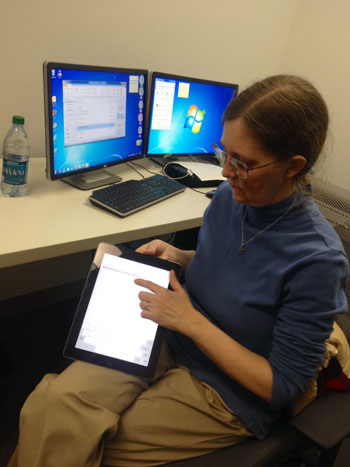
Technology can open up a world of possibility, but it also has the potential to leave a lot of people behind.
This is particularly true in the world of higher education, where sometimes it acts as the bridge that helps institutions provide equal access to education. Solutions like screen readers, voice-controlled typing and captioned videos are a few of the ways in which technology can help students with disabilities access and interact with online educational content.
But sometimes technology can be blamed for creating a gap in the learning environment.
It may seem like a daunting task, then, to ensure equal access to education for all. But Teresa Haven has made that her priority at Northern Arizona University.
The seasoned accessibility analyst recently joined the Office of Affirmative Action and Equal Opportunity to work with “just about everyone” throughout the university who needs help accessing or creating accessible educational content.
“Universities are no longer just physical places where students come into a classroom, read a textbook or listen to a lecture,” she said. Because of advances in technology, more and more education occurs digitally.
“A visually impaired person who cannot see his computer screen might encounter what seems to be an absolutely blank screen because he’s gone into a class or article that did not have accessibility planned,” she said.
A typical Band-Aid approach can be a lot of work and can be very stressful for both the student and the instructor to resolve. So rather than waiting until someone shows up with a problem that needs to be fixed, Haven is encouraging accessibility planning as a routine part of the university’s educational and business processes.
“Nationally, there is an emerging need to create open, accessible and usable environments—for employees, job applicants, parents, students, potential students, researchers for other institutions. Everyone out there is a potential person we need to be serving with an accessible environment,” she said.
That means designing environments successfully, so they serve those with disabilities but also those with older, slower technology. One student may need to log in to Blackboard by listening to the screen rather than seeing it. A hearing-impaired student may need to listen to a video that is required for an assignment, while someone else may be trying to view that same content in a noisy location where ambient sound may be interfering.
“Are there ways to get that information?” Haven asked. “Are there captions, transcripts, descriptions of the visual elements? Is there a way to play a movie without using a mouse to hit play?”
These are the kinds of questions Haven hopes the university community will begin asking from the start of a new course design or business process. This inclusive approach, she said, helps all students be better learners.
Haven already has been meeting with people from all areas of campus, offering support and information or resources, training and overall guidance on how to make a course or process more widely accessible.
“This really is not just about accessibility in the traditional sense, but it’s a much broader issue of usability that also will benefit those with older technologies, limited bandwidth, limited English proficiency and more,” she said.



